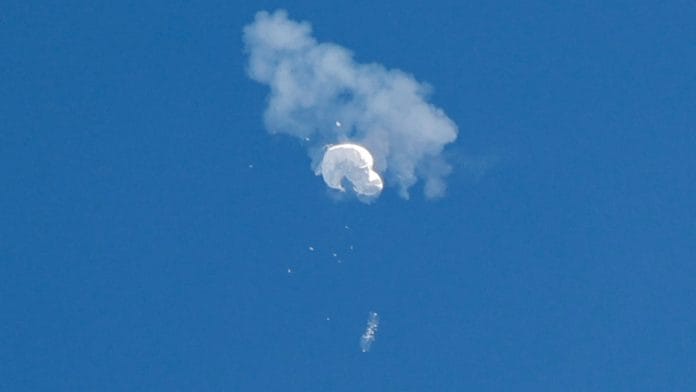New Delhi: A Chinese spy balloon and other unidentified airborne objects that were floating high over the United States and other parts of North America have raised serious concerns around the world.
On Sunday, the US shot down an octagonal object in its airspace, a day after it brought down a similar “cylindrical” object over Canada, the Pentagon said. It was the fourth aerial target that a US missile destroyed over North America in just over a week.
China has admitted that the first balloon – shot down by the US on 4 February while it was floating above the Atlantic – was its civilian airship “used for research, mainly meteorological purposes”. It has denied any involvement with the other three high-altitude airships.
Amid the tumult, old Chinese media reports have surfaced about Beijing’s top aeronautics scientist Wu Zhe, who launched a scheme four years ago to see the “world from above”.
In 2019, Zhe made a proud announcement that received little attention back then, The New York Times reported.
Zhe told a state-run news outlet that his team had launched a ship more than 60,000 into the air and sent it sailing around most of the globe, including across North America.
The airship “Cloud Chaser,” as per Wu, was a milestone in his vision of populating the upper reaches of the earth’s atmosphere with steerable balloons that could be used for early disaster alerts, pollution monitoring, or aerial surveillance.
“Look, there’s America,” Professor Wu said in a still from a video in 2019 showing a map of the world with a red line tracing its way across the globe and crossing over North America, which he claimed showed the trajectory of his “Cloud Chaser”.
According to The New York Times, the aim of the project that was backed by the Chinese government was to use high-altitude airships to track earthbound activity, along with keeping an eye on both domestic and military needs.
Wu’s boasts almost certainly verifies concerns that China has carried out a lengthy surveillance programme, using slow-moving, high-altitude devices to float over mainland US.
Citing Chinese media reports and academic archives, The New York Times also reported that Wu Zhe was quickly roped in to play a central role in China’s balloon development projects.
Professor Wu, a distinguished professor at Beihang University, a Beijing-based university at the forefront of China’s aviation and space research, has worked on the creation of airships for almost two decades.
Also read: Taiwan says it has spotted no Chinese surveillance balloons
China’s ambitions in ‘near space’ project
The 66-year-old aerospace scientist has become a key player in China’s planning of the “near space” project which deals with the band of atmosphere between 12 and 62 miles above earth – a level too high for planes and too low for satellites.
According to the report, Chinese strategists view “near space” as a field of intensifying great-power competition, where China must grasp cutting-edge materials and technologies required to forge a firm foothold — or run the danger of losing ground.
That anxiety has deepened as relations with the United States have soured under Xi Jinping, China’s absolutist leader.
Analysts involved in the Chinese project claim that “near space” presents a potentially practical substitute for satellites and surveillance aircraft, which might become exposed to detection, blockage, or attacks.
Near space “is a major sphere of competition between the 21st century military powers,” Shi Hong, a Chinese military commentator wrote in a current affairs journal last year, as per The New York Times report. “Whoever gains the edge in near space vehicles will be able to win more of the initiative in future wars,” he added.
High-altitude balloons are constructed from specialised materials that can withstand the harshest temperatures and transport payload in thin air.
It is clear from Professor Wu’s open academic publications and other sources that he and his research associates have long investigated these challenges.
In 2015, the Communist Party’s newspaper, “People’s Daily”, hailed the work of Professor Wu and his team after they launched a balloon in northern China that stayed aloft at more than 65,000 feet. That was a breakthrough for China in developing the material and knowledge for long-endurance, near-space voyages, the report said.
No accountability
China said on Monday that US high-altitude balloons had flown over its airspace without permission more than 10 times since the beginning of 2022. Washington has denied the claims, as per a Reuters report.
“Since last year, the US’ high-altitude balloons have undergone more than 10 illegal flights into Chinese airspace without the approval of the relevant Chinese departments,” Chinese foreign ministry spokesperson Wang Wenbin said at a regular briefing in Beijing in response to a question. Wang did not specifically describe the balloons as military, or whether they were used for espionage and did not provide further details.
The White House promptly denied China’s accusation, which National Security Council spokeswoman Adrienne Watson dismissed as an effort at damage control by Beijing.
“Any claim that the U.S. government operates surveillance balloons over the PRC (People’s Republic of China) is false,” she said in a statement.
“It is China that has a high altitude surveillance balloon program for intelligence collection, connected to the People’s Liberation Army, that it has used to violate the sovereignty of the United States and over 40 countries across five continents,” she added.
Also read: President Biden has sought broad assessment of China’s intelligence capabilities: White House






